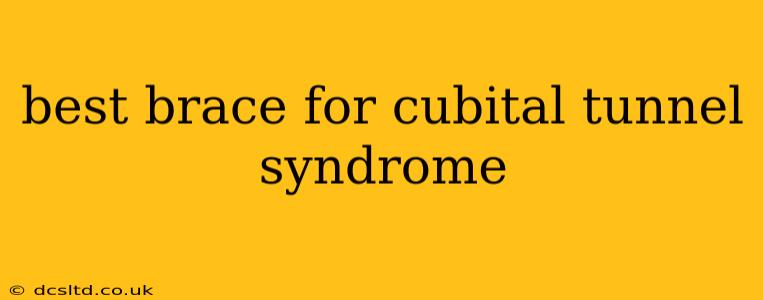Cubital tunnel syndrome, a condition causing numbness, tingling, and pain in the little finger and ring finger, often stems from pressure on the ulnar nerve at the elbow. Finding the right brace can significantly alleviate these symptoms and improve your quality of life. But with so many options available, choosing the best brace for cubital tunnel syndrome can feel overwhelming. This comprehensive guide will help you navigate the choices and find the perfect fit for your needs.
What is the Best Type of Brace for Cubital Tunnel Syndrome?
There isn't a single "best" brace, as the ideal choice depends on individual factors like the severity of your symptoms, your lifestyle, and personal preferences. However, most effective braces share some key features:
-
Elbow Support and Positioning: The primary function of a cubital tunnel brace is to keep your elbow slightly flexed (bent) at approximately 30-45 degrees. This position helps to reduce pressure on the ulnar nerve. Look for braces with adjustable straps to ensure a comfortable and effective fit.
-
Padding and Comfort: Prolonged wear is often necessary, so comfort is paramount. Choose a brace with soft, breathable padding to prevent skin irritation and chafing. Consider materials like neoprene or breathable fabrics.
-
Adjustability and Fit: A properly fitting brace is crucial. Look for adjustable straps and a design that accommodates your arm's shape and size. A poorly fitting brace can worsen your symptoms.
-
Lightweight and Discreet: For everyday wear, consider a lightweight and relatively discreet design. Some braces are designed to be worn under clothing.
What are the Different Types of Cubital Tunnel Braces?
Several types of braces effectively manage cubital tunnel syndrome:
-
Simple Elbow Braces: These often feature a flexible sleeve with straps to provide gentle support and maintain a slightly bent elbow position. They're generally less expensive and more discreet.
-
Rigid Elbow Braces: These offer more significant support and immobilization, often featuring a hard plastic or metal component to keep the elbow in place. They're generally more suitable for severe cases or during the initial stages of treatment.
-
Wraparound Braces: These braces wrap around the elbow, providing support and compression. They are often adjustable, allowing you to customize the level of support.
-
Custom-Made Braces: For individuals with unique anatomical needs or severe cases, a custom-made brace from an orthotist might be the most effective option.
How Do I Choose the Right Brace for My Needs?
Severity of Symptoms:
- Mild Symptoms: A simple, comfortable elbow brace offering gentle support and positioning might suffice.
- Moderate to Severe Symptoms: A more rigid brace, providing better immobilization, may be necessary.
Lifestyle:
- Active Lifestyle: A lightweight, breathable brace that allows for a range of motion may be preferable.
- Sedentary Lifestyle: Comfort and ease of wear are more important considerations.
Personal Preference:
- Comfort: Prioritize braces made of soft, breathable materials.
- Ease of Use: Choose a brace with adjustable straps and a simple design.
What Are Some Other Ways to Manage Cubital Tunnel Syndrome?
How can I relieve cubital tunnel pain without a brace?
Besides bracing, several other strategies can help manage cubital tunnel syndrome:
- Over-the-counter pain relievers: Ibuprofen or naproxen can reduce pain and inflammation.
- Physical therapy: Exercises can strengthen the muscles surrounding the elbow and improve nerve function.
- Corticosteroid injections: These can reduce inflammation in the affected area.
- Surgery: In severe cases, surgery may be necessary to relieve pressure on the ulnar nerve.
How long should I wear a cubital tunnel brace?
The duration of brace wear varies depending on the severity of your condition and your doctor's recommendations. It might range from a few weeks to several months.
Can I sleep with a cubital tunnel brace?
Wearing a brace while sleeping can be helpful in maintaining proper elbow positioning and reducing nighttime pain. Choose a comfortable brace suitable for overnight wear.
Can a cubital tunnel brace prevent surgery?
In many cases, consistent use of a brace, coupled with other conservative treatments, can significantly alleviate symptoms and potentially avoid the need for surgery. However, surgery may still be necessary for severe or unresponsive cases.
Choosing the right brace is a crucial step in managing cubital tunnel syndrome. By considering your individual needs and preferences, and consulting with your doctor or physical therapist, you can find the best support and relief, improving your comfort and overall quality of life. Remember, this information is for educational purposes only and does not constitute medical advice. Always consult a healthcare professional for diagnosis and treatment.
